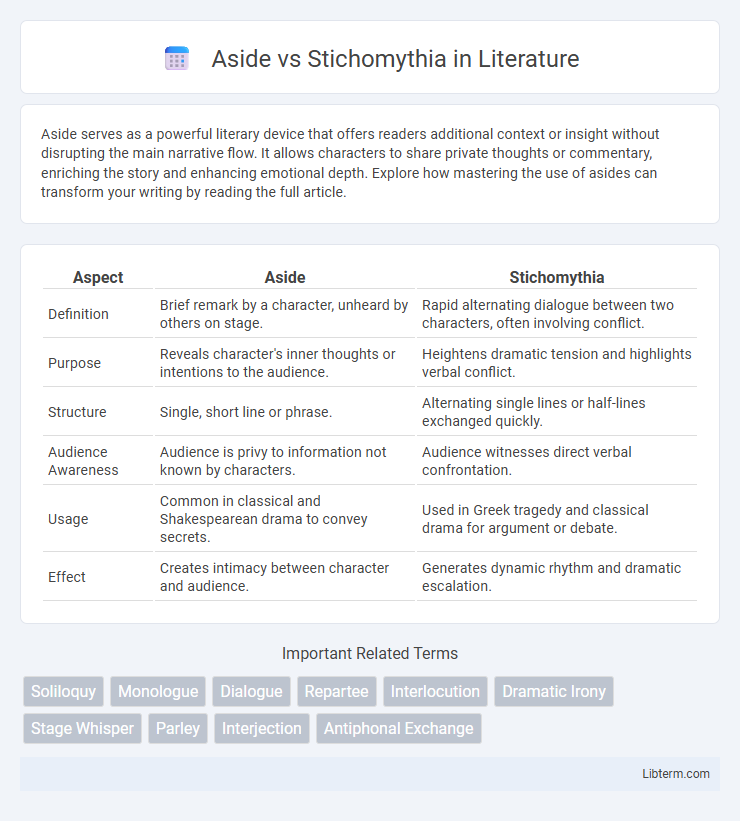Aside serves as a powerful literary device that offers readers additional context or insight without disrupting the main narrative flow. It allows characters to share private thoughts or commentary, enriching the story and enhancing emotional depth. Explore how mastering the use of asides can transform your writing by reading the full article.
Table of Comparison
| Aspect | Aside | Stichomythia |
|---|---|---|
| Definition | Brief remark by a character, unheard by others on stage. | Rapid alternating dialogue between two characters, often involving conflict. |
| Purpose | Reveals character's inner thoughts or intentions to the audience. | Heightens dramatic tension and highlights verbal conflict. |
| Structure | Single, short line or phrase. | Alternating single lines or half-lines exchanged quickly. |
| Audience Awareness | Audience is privy to information not known by characters. | Audience witnesses direct verbal confrontation. |
| Usage | Common in classical and Shakespearean drama to convey secrets. | Used in Greek tragedy and classical drama for argument or debate. |
| Effect | Creates intimacy between character and audience. | Generates dynamic rhythm and dramatic escalation. |
Understanding Aside: Definition and Purpose
An aside is a dramatic device where a character speaks directly to the audience, revealing inner thoughts or intentions that other characters on stage do not hear. Its purpose is to provide insight into the character's mindset, create suspense, or offer commentary on the unfolding action. Unlike stichomythia, which involves rapid dialogue exchanges between characters, asides serve to break the fourth wall and deepen audience engagement with the narrative.
What is Stichomythia? A Brief Overview
Stichomythia is a dramatic technique characterized by brief, rapid exchanges of dialogue between two characters, often found in classical Greek and Elizabethan drama. This form of alternating one-liners heightens tension and emphasizes conflict or emotional intensity within a scene. Unlike an aside, which is a character's private comment to the audience, stichomythia involves direct verbal sparring that propels the narrative forward through sharp, concise interaction.
Historical Origins of Aside and Stichomythia
The aside originated in Ancient Greek and Roman theater as a brief remark by a character intended for the audience's ears only, creating a direct connection and revealing internal thoughts or intentions. Stichomythia emerged in classical Greek drama, particularly in the works of Sophocles and Euripides, characterized by rapid alternating single lines of dialogue between characters, emphasizing conflict and emotional intensity. Both techniques served distinct dramatic purposes: asides for intimate audience engagement and stichomythia for heightening tension within the narrative.
Structural Differences Between Aside and Stichomythia
Asides are brief, direct comments delivered by a character to the audience or themselves, breaking the fourth wall without interrupting the main dialogue flow. Stichomythia involves rapid, alternating single lines of dialogue between two characters, creating a rhythmic exchange that heightens dramatic tension within the scene. Structurally, asides function as isolated, standalone remarks, while stichomythia relies on interactive, back-and-forth verbal sparring.
Functions in Dramatic Dialogue
Aside serves to reveal a character's inner thoughts directly to the audience, creating dramatic irony and deepening emotional engagement without interrupting the flow of the dialogue. Stichomythia functions as a rapid exchange of single lines between characters, intensifying conflict and highlighting verbal sparring to enhance dramatic tension. Both techniques drive the plot forward by providing unique insights and escalating interpersonal dynamics within a scene.
Emotional Impact on the Audience
Aside delivers emotional impact through direct communication with the audience, revealing a character's innermost thoughts and feelings that other characters are unaware of, creating intimacy and dramatic irony. Stichomythia heightens emotional tension by presenting rapid, alternating lines between characters, intensifying conflict and emphasizing psychological struggle. This technique generates a dynamic and confrontational atmosphere, engaging the audience emotionally through the rhythm and sharpness of verbal exchanges.
Usage in Classical and Modern Theatre
Aside and Stichomythia are distinct dramatic techniques used in classical and modern theatre to convey character thoughts and tension. In classical theatre, an aside allows a character to directly address the audience, revealing inner thoughts without other characters' awareness, whereas stichomythia consists of rapid, alternating dialogue lines between characters, heightening emotional intensity and conflict. Modern theatre adapts asides for breaking the fourth wall and uses stichomythia-like exchanges to maintain rhythmic pacing and dramatize confrontations.
Notable Examples in Literature
Aside and Stichomythia are prominent dramatic techniques used to convey characters' inner thoughts and rapid dialogue exchanges, respectively. Notable examples of asides appear in Shakespeare's *Hamlet*, where Hamlet frequently addresses the audience to reveal his thoughts, while Stichomythia is vividly employed in *Electra* by Sophocles, showcasing intense verbal sparring between characters. These techniques enhance dramatic tension and character development by breaking conventional dialogue patterns.
Aside vs Stichomythia: Strengths and Limitations
Aside allows characters to reveal inner thoughts directly to the audience, enhancing intimacy but limiting interaction with other characters. Stichomythia offers rapid, rhythmic dialogue exchange that heightens dramatic tension and conflict, though it can be challenging to sustain without clarity loss. Both techniques serve distinct narrative purposes; asides excel in showcasing internal monologues, while stichomythia thrives in dynamic confrontations.
Choosing the Right Device for Dramatic Effect
Choosing between an aside and stichomythia depends on the desired dramatic impact and audience engagement. An aside provides intimate insight into a character's thoughts, breaking the fourth wall and creating a personal connection with the audience. Stichomythia, characterized by rapid, alternating dialogue, intensifies conflict and highlights tension between characters, making it ideal for heightened dramatic exchanges.
Aside Infographic

 libterm.com
libterm.com